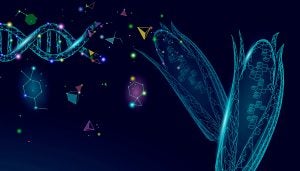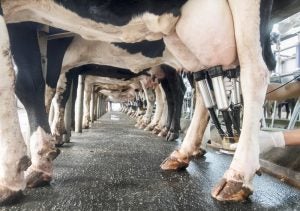Regulatory genes — genes that control how other genes are used — are responsible for 69 percent of the heritability of dairy cattle traits such as milk production and fertility.
According to a study published today in the journal Cell Genomics, this contribution is 44 percent more than expected and much higher than previous studies of human regulatory genes.
The findings, reported by a team of animal and human geneticists, could improve the efficiency of agricultural breeding programs. The study also helps solve the longstanding mystery of why mammalian genomes contain so much noncoding DNA.

“We suspect that our large sample size is one of the major reasons why we see that mutations affecting gene expression and RNA splicing are playing a major role in shaping traits,” says computational scientist and first author Ruidong Xiang of the University of Melbourne.
Most of our genome comprises “noncoding” DNA that does not code for protein, but the exact function of these noncoding regions remains a mystery. Because many genes in these noncoding regions are associated with specific traits like body size or hair color, scientists have long suspected that these genes contribute to an individual’s physical features or “phenotype” by regulating how other genes are used.
However, until now, there has been limited evidence supporting a significant role of regulatory genes in determining traits. For example, a recent human study estimated that only 11 percent of trait heritability is attributable to regulatory genes that alter gene expression.
“This creates a paradox called ‘missing regulation,’” says Xiang. “We decided to look at this problem to see how much variation in cattle traits can be explained by mutations changing gene expression or RNA splicing.”
To do this, the team first used the Cattle Genotype-Tissue Expression (CattleGTEx) atlas to build a model of regulatory genes, including both gene expression and RNA splicing genes. Then, they used their model to quantify how mutations in these regulatory genes impacted the heritability of traits in a separate dataset comprised of more than 120,000 dairy cattle genomes.
They examined 37 traits related to milk production, mastitis, fertility, temperament, and body size.

The researchers found that regulatory genes were responsible for 69 percent of trait heritability, as an average across 37 analyzed traits. “We were surprised, but we performed several validation tests, and the results were consistent, so we began to be convinced that this is the answer, at least in cattle,” says Xiang.
Unlike most prior studies that only examined gene expression variants, this study simultaneously examined both gene expression and RNA splicing genes. They also examined both cis and trans variants — mutations located close or far away, respectively, from the coding region they impact. Most other studies have focused only on the effects of nearby cis mutations.
Still, the researchers say that including trans modifications in the analysis gave another boost to their power that probably contributed to this study’s surprising result.
“Trans effects still haven’t been well studied, but we showed that these distant regulatory genes also play an important part in shaping mammalian traits—it appears to be less important than cis effects, but it is important,” says Xiang.
These findings could be a boon to farmers who selectively breed certain cattle traits. “By mapping genetic variants related to gene expression and RNA splicing, we can map the majority of the heritability of traits,” says Xiang. “Therefore, basic knowledge of the mechanisms behind mutations can be used to enhance applications such as breeding in agriculture.”
Beyond agriculture, this study helps by providing a model system for future studies in humans and other animals. “The next step is to use this information to try and generate better predictive models for different traits,” says Xiang. “Our methods could also be used as a model for other species.”
»Related: Plant-genomic advances guide the future of food and climate


